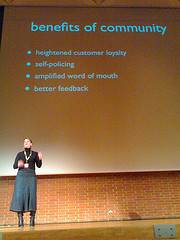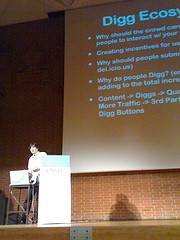Written by David Lenehan of Polldaddy
and edited by Richard MacManus. This is David’s account of the first day of the FOWA
conference in London. Photos in this post are by donkeyontheedge (I hope he doesn’t mind me
using them).
The Future Of Web Apps 2007 kicked off in London
today with a host of speakers from various startups, bigcos, media outlets and associated
businesses. Hosted by Ryan Carson of Carson
Systems, the event is covering what various successful web companies are currently
doing, why they are successful, and where they are headed.

Mike Arrington: The Future of Start-Ups and Web Companies
With a lack of Wifi access, most speakers have had a very attentive audience. First up
on the podium this morning was Michael Arrington from TechCrunch. Arrington first apologized for the
closure of TechCrunch UK. He hopes the site will be up and running again soon (and
talking to him after the show, he hinted that he had found a new blogger to take over
this role). He dealt with a few big issues that web companies are facing today. Firstly,
bubble 2.0 – are we in a bubble? He pointed out that last year in the US, TechCrunch
covered $600 million of VC money that had been invested into new startups; while on the
other hand, for example, Google bought YouTube for $1.65 billion. So that deal alone was bigger than the total invested in startups that year. His point was that the money being
put in by investors is a lot less that the money being put in by existing companies.
Instead of being in a bubble, we have not yet seen the peak of what’s happening in this
new web 2.0 era. He said there are still a lot more big applications, as important as
Digg, Flickr, YouTube etc, waiting to come online. He also felt that the new Adobe
platform Apollo is going to be big news and will help bridge the gap between the web and
desktop. Adobe is a sponsor of this event and were on hand in the reception area,
showing off some slick looking applications written in Apollo. However they shied away
from questions regarding the ever-changing launch date.
Community Building
Next up was Edwin Aoki, a
chief architect with AOL, who went through the importance of building user trust in your
products, and protecting their privacy and personal identities. This seemed like more of
a confidence-building exercise for AOL, given their data leak last year. He also pointed
out that email is still the biggest destination on the web, and not community
sites such as MySpace.

Tara Hunt from Citizen Agency followed on
that theme of community building and its importance for any startup who wants to build up
a large user/customer base. She talked about the importance of company founders and
developers alike continuing to have a role in customer support, in order to build
confidence with your user base.
Commoditizing the web
Simon Wardly from Fotango gave a colourful and
humorous talk about the importance of commoditizing the web, finishing with a pitch for
his own product Zimki – which launched last year.
Zimki is part Ning, part Amazon EC2. It’s a Javascript-based platform where developers
can contribute application functionality to an already large collection of Zimki modules,
and then build applications from them. Zimki will host your application and you pay for
storage and computing power. It seems quite reasonably priced and they are going open
source it this year. But most developers I have talked to here said that as with Ning, if
they are building a big application, they are much more comfortable building it
themselves – and are not interested in building on these types of platforms. Time will
tell if Zimki can remove the need for coders from the process of building online
applications.
Ben Holmes: Getting VC Money
Best of the day up to this point was Ben Holmes from Index Ventures, who gave a fascinating and
honest talk about the process involved in startups getting VC money. According to Ben,
the thing that VC’s are looking for, more so than people with good ideas, are people who
are passionate about their ideas and can sell them. They also look for people who have
excellent development teams who can execute their ideas. Index Ventures have invested in
the past in Skype, Betfair, Last.fm and more recently in Netvibes. Their portfolio of
past investments makes for good reading. According to Ben, when looking for VC money, the
average startup can expect to have to swallow the following hard requirements:
1.) You will have to give up an average of between 20% to 35% of your ownership
2.) VC representation on your board
3.) Liquidation option for worst case scenario
4.) Participation rights
5.) Reverse Vesting (If you leave your company earlier than an agreed time your 65% to
80% ownership can be cut significantly)
6.) Certain control, and veto rights
7.) option pool
One thing that might be a big issue for a lot of startup founders is that a lot of VCs
will not let you sell until such a point that they feel that you have peaked in terms of
your company performance. So if you get an offer one year later of a few million, that
might make you a rich happy retiree, they are probably going to make you hold out a lot
longer and for a lot more money. The pre-requisites for getting VC funding are simple:
you need to have a unique product or concept; you need to have an excellent development
team; and your idea needs to have a large potential market. It was interesting to note
that Ben also gave a list of reasons why you should not get VC funding:
1.) You will probably miss out on the option of any small exit opportunity, which in a
lot of cases could be very lucrative personally;
2.) You will be bound to a minimum of 3+ years of hard work building your idea up;
3.) You will lose the opportunity to run a lifestyle business.
In the end, if you have a great product then you need to focus on your business and
not on fundraising. You need to build up the PR of your company and get your name out
there. VC’s spend most of their time looking around for new companies to invest in, so if
you get your name out there and people like your product, then the VC’s will come to you
– guaranteed. If you decide to take VC investment, its important to find a group that is
interested in your product, do not have any competing products on their books, and are
willing to help you with recruitment, business development, and exit strategies, and not
just funding you.
Last.fm, Thinkfree, Google Sketchup
Matthew Ogle and
Anil-Bawa-Cavia from Last.fm gave an overview of their
company history, from its humble origins on a rooftop patio somewhere in London to their
more comfortable offices of today. They claim that 15 million tracks are listed every day
on the site, with a total of 6 billion items listed from day one. This is a huge amount
of data and they talked about how they scaled their systems to cope with this.

Tj Kang from Thinkfree was next on, promoting
their online office suite – which is free to use and I have been told is quite good. They
also have an API for bloggers and website owners to convert their Microsoft Office files
to a MSO free format, by passing their documents through the Thinkfree API and getting a
flash or HTML document on the other end, that is delivered to the web user.
Jason Chuck from Google went through some of the features of Google Sketchup and
showed some nice examples of user generated content.
Werner Vogels: Emergent Design
Werner Vogels, Vice President and CTO of Amazon, talked about emergent design and
becoming more flexible with how your service or application will serve its users in the
future. He placed a lot of importance on knowing your required resources; when you need
them; being able to use them when you need to; and not pay for them when you’re not using
them. All of this of course ties in nicely with Amazons S3 storage and EC2 cloud
computing products. He gave the example of Smugmug.com,
who were spending $40,000/month on hosting, but after switching to S3 saved almost
$500,000 dollars in the first 7 months.
Quotations Book, Soocial.com
Quotations Book is a new site that is launching in the coming weeks. From what I
gather, it’s a search engine for quotes. You can place a quote widget on your site,
and….. well if you like quotes, I guess you will like this site.
Soocial.com is a new site (not launched yet)
that brings together all of your contacts on your blackberry, mobile phone, laptop, and
PC. With a Soocial account, when you add a new contact to your list from, lets say an
email, that same contact or .vcf info will be added to the contact list on your phone and
all of your other devices. Their goal is to remove all of the syncing problems involved
in managing contact lists across multiple devices.
Kevin Rose, Digg
The last speaker of the
day was Kevin Rose from Digg. He gave an interesting
insight into the history of the company and what goes on behind the scenes. He talked
about enabling Digg users who regularly digg the same stories and are nearby
geographically, to hook up and become friends. He also wants Digg to start showing you
stories based on what you have digged in the past.

Kevin announced plans for a Digg API that you can use to create a Digg swarm, that
tracks Digg data relating to your own website – which you can then use for your own
purposes. He also announced support for OpenID on Digg in the near future (add that to Microsoft’s
and AOL’s support for
OpenID!).
Conclusion, Day 1 of FOWA
In the end there was nothing new announced here today, it was more of a big discussion
about current products and current news.
Whether or not startups should focus on a business plan or not, was debated again
and again. Mike Arrington said yes; Tara Hunt said no; Ben Holmes said yes, but not too
much.
Everyone is pushing Adobe Apollo, there is lots of talk about attention data, and
everyone we heard speaking today talked about the importance of building community for
your users and shaping your application based on their feedback.
No mention of mobile technologies, semantic web, or web OS. Maybe I’m getting a bit
ahead of myself, but those things are the future of web apps after all! More news
tomorrow…
Ed: Big ups to David Lenehan for this thorough report. Looking forward to his
report on Day 2 of the Future Of Web Apps conference.










